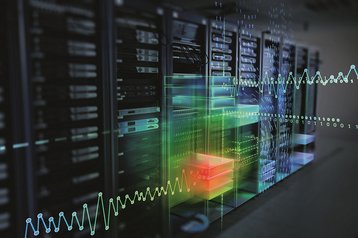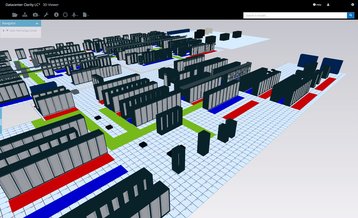Merger and acquisition activity is set to reshape the multi-tenant data center market: The popularity of colocation data centers is on the rise. At the same time, the industry demands greater levels of operational efficiency backed by service level agreements, transparency and reporting. Data center infrastructure management (DCIM) offers the required transparency and performance measurement of activities in colo data centers.
Typically, a colo data center provides the building, cooling, power, bandwidth and physical security while the customer provides servers and storage. Space in the facility is often leased to customers by the rack, cabinet, cage or room. Colo offerings reflect the pulse of the market, as evidenced by the growth forecasts of 451 Research: The market researchers calculated how much space data centers worldwide will occupy by 2020. Their findings indicate that the colo market is outperforming other types of data centers, reaching annual growth rates of eight percent.
DCIM ensures transparency
Many colo data centers have extended their offerings by customer demand to include DCIM. DCIM tools offer asset management, central data center management – a “single pane of glass” – improved forecasting and an extended lifecycle. For the colo data center customers DCIM provides complete visibility in order to track and monitor the performance of their assets.
A bridge between FM and IT
For colo data centers DCIM forms a bridge between facilities management and IT operations by providing a single, comprehensive view of both areas. It monitors the use and energy consumption of IT-related equipment and facility infrastructure components. The decision by colo data centers to adopt DCIM tools marks a significant shift in attitudes. Three to five years ago, quantifying the value of DCIM was difficult, and the tool itself was seen as more of a luxury than a necessity for small- to mid-size businesses.
Today, DCIM represents a win-win for both colo data centers and customers alike. For customers, operating with a colo data center provider will allow them to customize their data center processes to meet specific workflow needs. This ensures that DCIM solutions will provide maximum benefits and reduce the risk of roadblocks in data access and use. DCIM tools will provide companies flexibility to adjust operations quickly. This will permit a company to increase analytics and the workflow substantially as required and reduce operations when they don’t need optimal analytics power.
As increased competition is driving market consolidation, data center managers are recognizing the importance of tools such as DCIM to their own organizations and the benefits it can bring to their customers. DCIM is now seen by many as being business critical not only to remotely manage and benchmark multiple colo data center sites but also for the security of those sites.
Good DCIM software will provide real-time visualization and monitoring of asset attributes and tools to determine the most efficient data center configuration. Real-time monitoring of assets is an essential feature of a DCIM product. Sensors and data collector software can acquire operational and environmental data throughout the data center. Combined with asset management this ensures that energy, equipment and floor space are used as efficiently as possible.
With DCIM, colo data centers gain live, actionable data that allows immediate response and better control of their facility and customers IT assets.
Integrating third parties
With the data center market consolidating, the fusion of multiple business systems is common place with an ever-growing need for the DCIM to integrate with third-party vendors. Having an open protocol interface to facilitate such integration is important as data center managers are increasingly recognizing that such DCIM integration can provide competitive advantages. Today colo data centers are readily investing in DCIM as it is seen by both data centers and customers to be one of the most important tools needed to complement any data center facility infrastructure. It can be described as the command center with the software providing a comprehensive overview/transparency for making decisions based on real facts.
Multiple business systems must be integrated during mergers and acquisitions, and this affects colo data centers which must be scalable and effectively managed on a global basis.
The integration of multiple business systems, a frequent requirement during mergers and acquisitions, also means that the system capacity of colo data centers must be scalable and effectively managed and delivered on a global basis. Critical functions such as rack space, power, cooling and network connectivity, require close oversight which is achieved through a KPI-based client dashboard. However, asset moves, adds and changes (MACs) can create an imbalance in capacity utilization and can result in stranded assets - unidentified and underutilized capacity on some servers while demand exceeds resources on others. Without clear insight into available capacity, operators could invest in unneeded assets while others sit underutilized.
The result is a negative impact on profitability at a time when capital is needed for growth. To better manage such capacity issues, colo data center operators can utilize DCIM tools that will reduce costs and improve capacity utilization. With sophisticated tracking and reporting capabilities, DCIM allows colo data centers to accurately assess capacity levels of all of their assets. IT managers better control capacity and workflow to maximize usage. Facility managers can maximize environmental conditions to help prevent costly downtime.
Billing on actual usage
DCIM systems offer another important advantage: real-time billing. Real-time billing improves customer transparency and is a tremendous advantage for accurate billing and budgeting. By tracking customer usage in real time, operators invoice customers based on actual usage. This may sound counter-intuitive to the traditional method of billing customers at a set fee. For customers, it gives access to new levels of data that will allow improved planning and perhaps expanded usage. Most importantly, customer satisfaction increases.
While costs for DCIM systems will vary depending upon the capabilities required to address particular challenges by the colo data center, perhaps it is more relevant to examine the added value that DCIM can provide. The ideal scenario is when a colo data center agrees with their customer the level of access and clarity given to them into the data center to monitor power consumption or real-time data gathering. It’s also important for colo data centers to understand that they need a process for DCIM. Without that, DCIM as a tool will not create a process for the business. This is key, as colo data centers expect to achieve full return on investment (ROI) on their DCIM system investment in two to three years or even less.
Philippe Heim is global portfolio manager DCIM at Siemens Building Technologies





